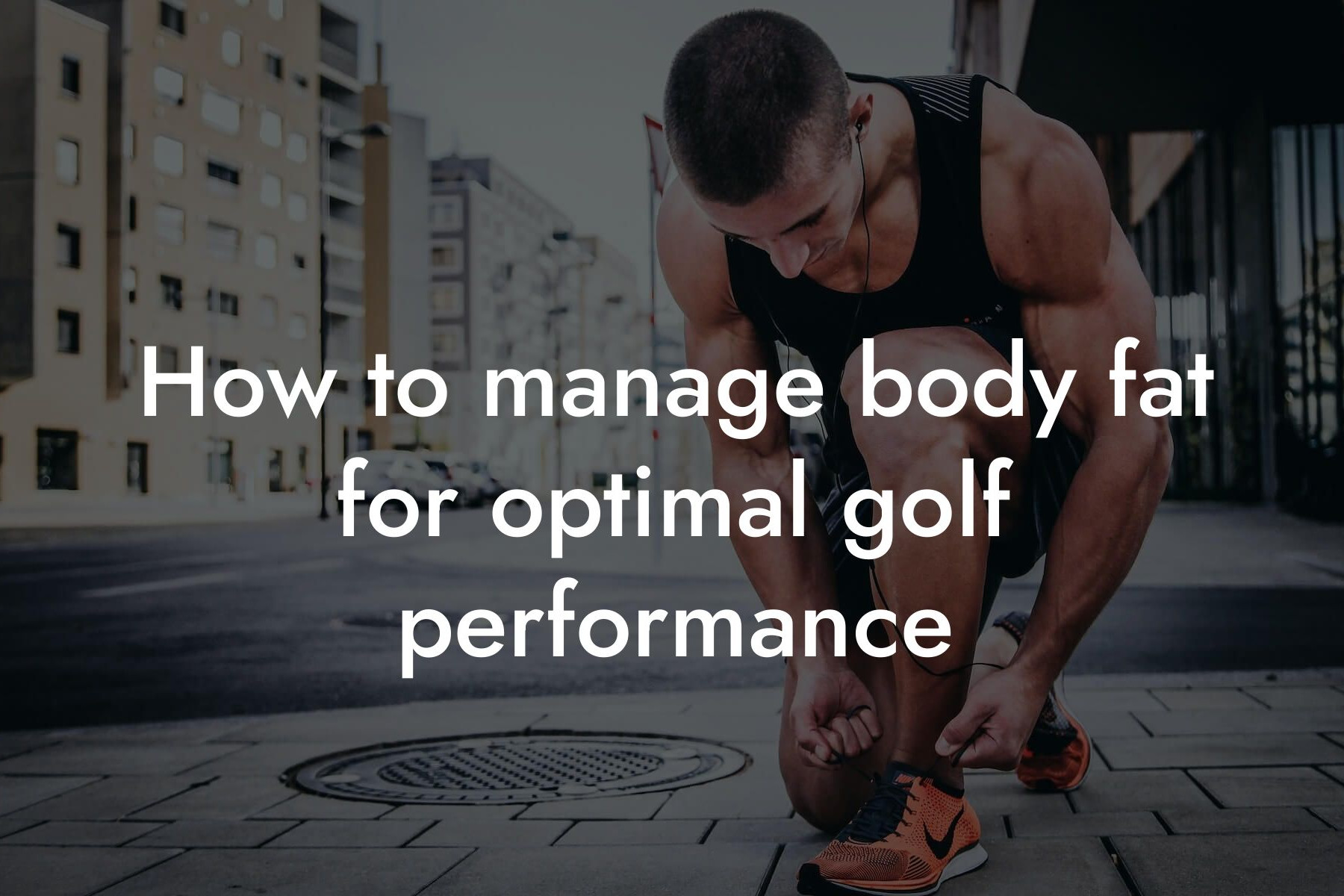Introduction
As a golfer, you understand the importance of maintaining a high level of physical fitness to excel in the sport. However, the off-season can be a challenging time to stay motivated and focused on your fitness goals. A well-structured off-season fitness program can help you improve your overall performance, reduce the risk of injury, and optimize your body composition. In this article, we'll provide you with a comprehensive guide to creating an effective off-season fitness program tailored to golfers.
Table of Contents
- Introduction
- The Importance of Off-Season Training
- Assessing Your Current Fitness Level
- Setting Goals and Objectives
- Creating a Periodized Training Program
- Strength and Power Training
- Endurance and Conditioning Training
- Flexibility and Mobility Training
- Nutrition and Recovery Strategies
- Frequently Asked Questions
The Importance of Off-Season Training
Many golfers make the mistake of taking an extended break from training during the off-season, only to find themselves struggling to get back into shape when the new season begins. This can lead to a decline in performance, increased risk of injury, and a slower start to the season. A well-planned off-season fitness program can help you:
- Maintain and improve your overall fitness level
- Enhance your strength, power, and endurance
- Improve your flexibility and mobility
- Optimize your body composition, including reducing body fat and increasing lean muscle mass
- Reduce the risk of injury and improve overall health
Assessing Your Current Fitness Level
Before creating an off-season fitness program, it's essential to assess your current fitness level. This includes evaluating your:
- Cardiovascular endurance
- Strength and power
- Flexibility and mobility
- Body composition, including body fat percentage and lean muscle mass
At Tano Performance Group, we recommend using a DEXA machine to provide a comprehensive body assessment. This advanced technology provides detailed information on your body composition, including bone density, lean muscle mass, and body fat percentage.
Setting Goals and Objectives
Once you've assessed your current fitness level, it's essential to set specific, measurable, and achievable goals and objectives for your off-season fitness program. This may include:
- Improving your overall fitness level
- Enhancing your strength and power
- Reducing body fat percentage
- Increasing lean muscle mass
- Improving your flexibility and mobility
Creating a Periodized Training Program
A periodized training program involves dividing your off-season into specific training phases, each with a unique focus and goal. This approach helps to avoid plateaus, reduce the risk of overtraining, and optimize your progress. A typical periodized training program for golfers may include:
- Phase 1: Active recovery and rehabilitation (4-6 weeks)
- Phase 2: Strength and power development (8-12 weeks)
- Phase 3: Endurance and conditioning (8-12 weeks)
- Phase 4: Pre-season preparation and fine-tuning (4-6 weeks)
Strength and Power Training
Strength and power training are essential components of an off-season fitness program for golfers. This type of training helps to improve your overall strength, power, and endurance, which can lead to increased driving distance, improved accuracy, and enhanced overall performance. Some effective strength and power exercises for golfers include:
- Squats and lunges
- Deadlifts and rows
- Bench press and shoulder press
- Leg press and calf raises
- Plyometric exercises, such as box jumps and depth jumps
Endurance and Conditioning Training
Endurance and conditioning training are critical components of an off-season fitness program for golfers. This type of training helps to improve your cardiovascular endurance, increase your stamina, and enhance your overall fitness level. Some effective endurance and conditioning exercises for golfers include:
- Cardiovascular exercises, such as running, cycling, or swimming
- High-intensity interval training (HIIT)
- Resistance band training
- Agility and speed drills
Flexibility and Mobility Training
Flexibility and mobility training are often overlooked in off-season fitness programs for golfers. However, these components are essential for maintaining and improving your range of motion, reducing the risk of injury, and enhancing your overall performance. Some effective flexibility and mobility exercises for golfers include:
- Static stretching exercises, such as hamstring and hip flexor stretches
- Dynamic stretching exercises, such as leg swings and arm circles
- Foam rolling and self-myofascial release
- Yoga and Pilates exercises
Nutrition and Recovery Strategies
A well-planned nutrition and recovery strategy is critical for supporting your off-season fitness program. This includes:
- Fueling your body with a balanced diet that includes lean protein, complex carbohydrates, and healthy fats
- Staying hydrated by drinking plenty of water
- Getting adequate rest and recovery time, including 7-9 hours of sleep per night
- Using recovery techniques, such as foam rolling, massage, and compression garments
A well-structured off-season fitness program can help golfers improve their overall performance, reduce the risk of injury, and optimize their body composition. By assessing your current fitness level, setting specific goals and objectives, creating a periodized training program, and incorporating strength and power training, endurance and conditioning training, flexibility and mobility training, and nutrition and recovery strategies, you can take your game to the next level. Remember to stay focused, motivated, and committed to your off-season fitness program, and you'll be ready to dominate the course when the new season begins.
Frequently Asked Questions
What is an off-season fitness program for golfers?
An off-season fitness program for golfers is a structured training plan designed to improve their physical fitness and golf performance during the period when they are not actively competing or playing golf regularly. The program focuses on building strength, endurance, flexibility, and mobility to enhance overall golf performance and reduce the risk of injury.
Why is it essential for golfers to have an off-season fitness program?
Having an off-season fitness program is crucial for golfers because it allows them to maintain and improve their physical fitness, even when they're not actively playing golf. This helps to prevent detraining, maintain muscle mass, and reduce the risk of injury when they return to playing golf.
What are the benefits of an off-season fitness program for golfers?
The benefits of an off-season fitness program for golfers include improved overall fitness, increased strength and power, enhanced flexibility and mobility, better balance and coordination, and reduced risk of injury. Additionally, it helps golfers to maintain their competitive edge and come back stronger and more prepared for the next golf season.
How long should an off-season fitness program for golfers last?
The duration of an off-season fitness program for golfers can vary depending on individual goals and needs. However, a typical program can last anywhere from 12 to 24 weeks, with a minimum of 3-4 months recommended for optimal results.
What types of exercises should be included in an off-season fitness program for golfers?
An off-season fitness program for golfers should include a combination of exercises that target strength, power, flexibility, mobility, and endurance. This can include exercises such as squats, lunges, deadlifts, bench press, rows, and rotational exercises, as well as plyometric and agility drills.
How often should golfers train during the off-season?
The frequency of training during the off-season can vary depending on individual goals and needs. However, a typical program may include 2-3 strength training sessions, 1-2 cardio sessions, and 1-2 flexibility and mobility sessions per week.
What is the importance of periodization in an off-season fitness program for golfers?
Periodization is essential in an off-season fitness program for golfers as it allows for varying levels of intensity and volume to avoid plateaus and prevent overtraining. It also helps to ensure that golfers peak at the right time and are fully prepared for the next golf season.
How can golfers incorporate cardio exercises into their off-season fitness program?
Golfers can incorporate cardio exercises into their off-season fitness program through activities such as jogging, cycling, swimming, or using a cardio machine at the gym. The goal is to improve cardiovascular endurance and increase stamina for the golf course.
What is the role of nutrition in an off-season fitness program for golfers?
Nutrition plays a critical role in an off-season fitness program for golfers as it helps to support muscle growth and recovery. Golfers should focus on consuming a balanced diet that includes lean protein, complex carbohydrates, and healthy fats, as well as staying hydrated by drinking plenty of water.
How can golfers track their progress during the off-season?
Golfers can track their progress during the off-season by setting specific, measurable, and achievable goals, and regularly assessing their performance through metrics such as strength, power, flexibility, and endurance. They can also use tools such as fitness trackers, heart rate monitors, and mobile apps to monitor their progress.
What are some common mistakes golfers make during the off-season?
Common mistakes golfers make during the off-season include not having a structured training plan, not incorporating variety in their training, not allowing for adequate rest and recovery, and not setting specific and achievable goals.
How can golfers stay motivated during the off-season?
Golfers can stay motivated during the off-season by setting specific and achievable goals, finding a workout buddy or joining a fitness group, tracking their progress, and rewarding themselves for milestones achieved. They can also focus on the benefits of training, such as improved overall health and fitness, rather than just focusing on golf performance.
What is the importance of flexibility and mobility exercises in an off-season fitness program for golfers?
Flexibility and mobility exercises are essential in an off-season fitness program for golfers as they help to improve range of motion, reduce stiffness, and enhance overall golf performance. They can also help to reduce the risk of injury and improve overall functional movement.
How can golfers incorporate plyometric exercises into their off-season fitness program?
Golfers can incorporate plyometric exercises into their off-season fitness program through activities such as jump squats, box jumps, and medicine ball throws. Plyometric exercises help to improve power, speed, and explosiveness, which are essential for golf performance.
What is the role of strength training in an off-season fitness program for golfers?
Strength training is a critical component of an off-season fitness program for golfers as it helps to improve overall strength, power, and endurance. It can also help to enhance golf performance by increasing clubhead speed, improving ball striking, and reducing the risk of injury.
How can golfers incorporate agility drills into their off-season fitness program?
Golfers can incorporate agility drills into their off-season fitness program through activities such as cone drills, ladder drills, and shuttle runs. Agility drills help to improve speed, quickness, and change of direction, which are essential for golf performance.
What is the importance of balance and coordination exercises in an off-season fitness program for golfers?
Balance and coordination exercises are essential in an off-season fitness program for golfers as they help to improve overall stability, reduce the risk of injury, and enhance golf performance. They can also help to improve balance and coordination on the golf course.
How can golfers incorporate core exercises into their off-season fitness program?
Golfers can incorporate core exercises into their off-season fitness program through activities such as planks, Russian twists, and leg raises. Core exercises help to improve overall core strength, stability, and endurance, which are essential for golf performance.
What is the role of rest and recovery in an off-season fitness program for golfers?
Rest and recovery are critical components of an off-season fitness program for golfers as they allow for muscle growth, repair, and adaptation. Adequate rest and recovery can help to reduce the risk of injury, improve overall fitness, and enhance golf performance.
How can golfers incorporate mental training into their off-season fitness program?
Golfers can incorporate mental training into their off-season fitness program through activities such as visualization, meditation, and positive self-talk. Mental training helps to improve focus, concentration, and overall mental toughness, which are essential for golf performance.
What are some common injuries golfers experience during the off-season?
Common injuries golfers experience during the off-season include lower back strains, shoulder impingement, elbow tendinitis, and knee pain. These injuries can be prevented or reduced by incorporating injury prevention exercises into the off-season fitness program.
How can golfers modify their off-season fitness program to accommodate injuries or physical limitations?
Golfers can modify their off-season fitness program to accommodate injuries or physical limitations by working with a fitness professional or physical therapist to develop a customized program that takes into account their individual needs and limitations.
What is the importance of seeking professional guidance when developing an off-season fitness program for golfers?
Seeking professional guidance when developing an off-season fitness program for golfers is essential as it helps to ensure that the program is tailored to individual needs and goals, and reduces the risk of injury or ineffective training. A fitness professional or golf-specific coach can help to design a program that addresses specific weaknesses and improves overall golf performance.
Here are some related articles you might love...
- How to manage body fat for optimal golf performance
- Strength training to improve golf performance
- Nutrition tips for maintaining focus and energy on the golf course
- The impact of body composition on golf swing power and accuracy
- The role of core strength in golf accuracy
- Bone density and injury prevention in golf
- Recovery strategies for golfers after a tournament
- How DEXA scans can benefit professional golfers
- Maintaining flexibility and muscle mass for a better golf swing
Zak Faulkner
Zak Faulkner is a leading authority in the realm of physical health and body composition analysis, with over 15 years of experience helping professionals optimise their fitness and well-being. As one the experts behind Tano Performance Group, Zak has dedicated his career to providing in-depth, science-backed insights that empower clients to elevate their physical performance and overall health.
With extensive knowledge of DEXA technology, Zak specializes in delivering comprehensive body assessments that offer precise data on body fat, muscle mass, bone density, and overall physique. His expertise enables individuals to make informed decisions and achieve their fitness goals with accuracy and confidence. Zak’s approach is rooted in a deep understanding of human physiology, combined with a passion for helping clients unlock their full potential through personalised strategies.
Over the years, Zak has earned a reputation for his commitment to excellence, precision, and client-focused service. His guidance is trusted by top professionals who demand the best when it comes to their health. Whether advising on fitness programs, nutritional strategies, or long-term wellness plans, Zak Faulkner’s insights are a valuable resource for anyone serious about taking their health and fitness to the next level.
At Tano Performance Group, Zak continues to lead our Content Team revolutionising how professionals approach their physical health, offering unparalleled expertise that drives real results.




